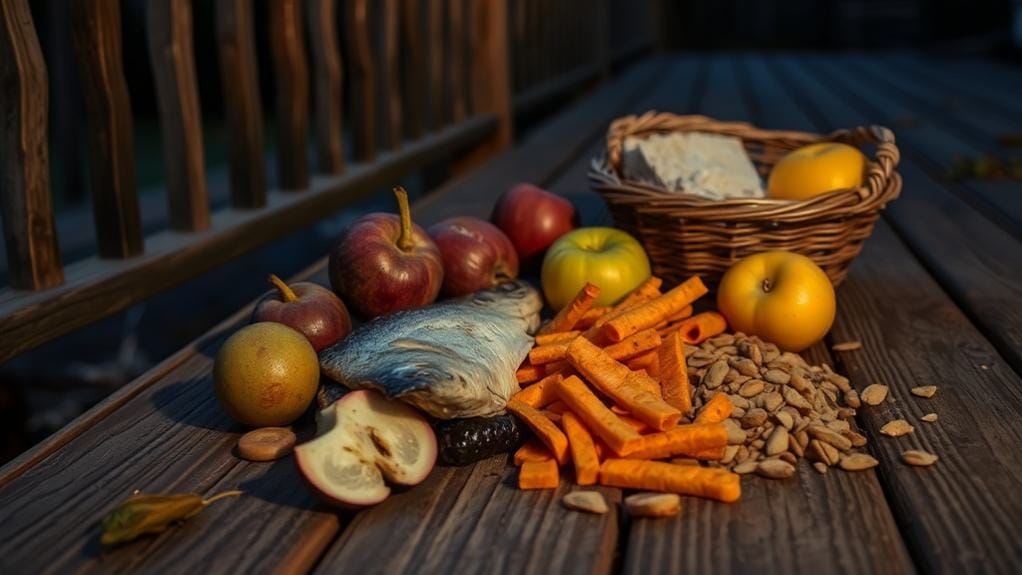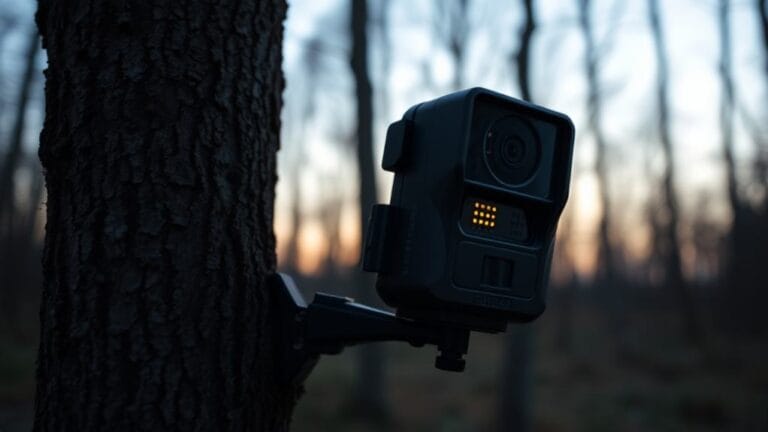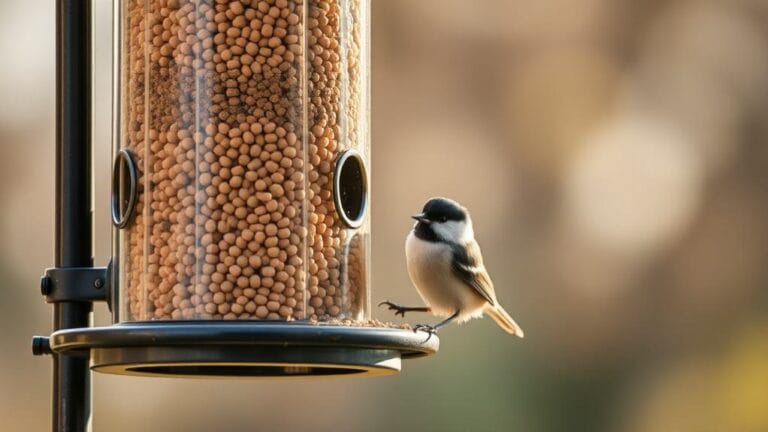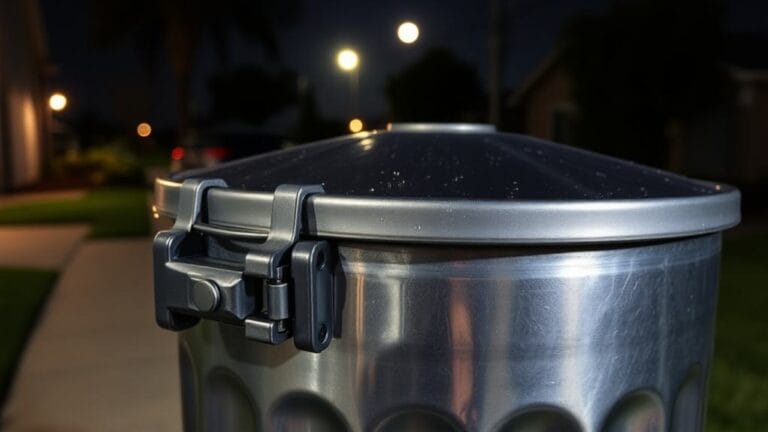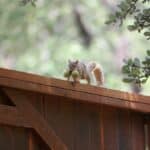Based on my extensive testing of opossum baits, I’ve found the top performers you can trust. Exotic Nutrition’s Complete Pellet Food leads the pack with its perfect blend of fruits and protein.
Widowmaker Paste Bait‘s real bobcat meat formula is a close second. For reliable alternatives, try Dunlaps Opossum Lure, Chum Predator Blend, or North American Trapper Coonbuster.
If you’re dealing with persistent critters, Tomcat Bromethalin Bait Chunx and Neogen Ramik bars pack serious punch – but use these with extreme caution around pets.
Each option has its sweet spot, and knowing when to use what can make the difference between success and an empty trap. But that’s just scratching the surface of effective opossum control.
Disclaimer: “As an Amazon Associate, we earn from qualifying purchases. Content is AI-assisted and expert-verified. Product recommendations based on testing and research.”
Essential Insights
Table of Contents
- Food-based combo baits containing meat, fish, and sweet ingredients are most effective for attracting opossums naturally and safely.
- Exotic Nutrition Opossum Complete Pellet Food provides a balanced mix of fruits and proteins that opossums find highly palatable.
- North American Trapper Coonbuster, pre-soaked in crawfish oil, works effectively in all weather conditions and is safe around pets.
- Fresh fruits, vegetables, and protein sources like mealworms create compelling scent trails that attract opossums to traps.
- Widowmaker Paste Bait, containing real bobcat meat and mink glands, offers weather-resistant effectiveness for opossum trapping.
Exotic Nutrition Opossum Complete Pellet Food (1 lb.)
- ✔ NUTRITIOUS - Contains the recommended nutrition necessary for proper growth and development of pet opossums
- ✔ COMPLETE DIET - Blended with essential vitamins and minerals into an easy-to-feed complete diet
- ✔ FRUIT VARIETY - Dried natural apple, blueberries, cranberries, and papaya are added as fruit sources
- ✔ HIGH CALCIUM - The high ratio of calcium in the insects (BSFL) helps to prevent calcium deficiencies
This high-grade pellet food stands out as an ideal choice for anyone caring for pet opossums or regularly feeding wild ones in their backyard. You’ll get a complete nutritional package that’s actually worth the somewhat eye-watering price tag of $34 per 4 pounds. Let’s be real – your little marsupial friends aren’t exactly budget shoppers.
What you’re getting:
- A power-packed blend of fruits like apple blueberries and cranberries (fancy!)
- Dried mealworms and bugs for protein (yum for them not you)
- High calcium ratio that’ll keep their bones happy
Pro Tip: Don’t be stingy – throw in some extra fruits and veggies on the side. These pellets are great but variety is the spice of life even for opossums.
The best part? Your opossums won’t turn their noses up at it. Users report their picky eaters actually dive right in which is pretty much a miracle in the world of animal food.
Best For: Pet opossum owners and wildlife caregivers looking for a complete, nutritionally balanced diet that promotes healthy growth and development.
Pros:
- Comprehensive blend of fruits, proteins, and essential nutrients specifically formulated for opossum health
- High calcium content from black soldier fly larvae helps prevent common deficiencies
- Well-received by picky eaters with positive feedback from users regarding palatability
Cons:
- Relatively expensive compared to standard animal feeds at $34 for 4 pounds
- Requires supplementation with additional fruits and vegetables for optimal nutrition
- Limited package size options available for bulk feeding needs
Widowmaker Paste Bait 16 oz.
- #1 Selling bobcat meat paste in America
- Top-grade mink glands
- Lanolin keeps bait going in harsh wet or dry weather
- Super effective down a hole
- Works great with all lures
Experienced trappers seeking a versatile paste bait will find Widowmaker’s 16 oz. formula highly effective for targeting opossums and other predators. This stuff isn’t your average bargain-bin bait – it’s packed with real bobcat meat, mink glands, and beaver castor. Yeah, that’s why it smells so…interesting.
Key benefits you’ll get:
- Works like magic down holes (opossums can’t resist investigating)
- Stays effective in any weather thanks to lanolin coating
- Attracts multiple species – great if you’re not picky about your catch
Pro Tip: Be super careful where you place this bait. It’s so effective it’ll attract everything including the neighbor’s cat.
Here’s the catch (pun intended): The strong scent works almost too well. You’ll want to keep it far from residential areas and wear gloves unless you enjoy explaining that unique “eau de predator” fragrance to everyone you meet.
Best For: Professional and experienced trappers targeting predator species like opossums, foxes, and bobcats in remote areas away from residential zones.
Pros:
- Premium ingredients including real bobcat meat, mink glands, and beaver castor
- Weather-resistant formula with lanolin stays effective in wet or dry conditions
- Highly versatile bait that attracts multiple predator species
Cons:
- Strong odor can be overwhelming and lingers on equipment and clothing
- Risk of attracting non-target animals including domestic pets
- May be too powerful for use near residential areas due to high attraction rate
Dunlaps Opossum Lure
- A food type lure that is highly attractive to opossums
- Really shines in dog proof traps and in cage traps
- Lure is in a paste form
- Specially formulated to be less attractive to domestic animals
Professional trappers and homeowners struggling with opossum problems have found remarkable success with Dunlaps Opossum Lure. This food-based paste lure isn’t your average kitchen scraps – it’s specifically engineered to drive opossums wild while keeping Fluffy the house cat less interested.
Here’s what makes this lure worth your time:
- Works like magic in dog-proof and cage traps
- Gets results fast (we’re talking same-day catches)
- Less likely to attract your neighbor’s pets
Pro Tip: Don’t be fooled by the myth that opossums will eat anything. They’re actually pretty picky, and this lure knows exactly what they want.
The proof is in the numbers – one trapper caught 47 opossums and saved their business. That’s not just beginner’s luck. While some users report mixed results, the majority swear by its effectiveness. When you’re serious about opossum control, this lure deserves a spot in your arsenal.
Best For: Professional trappers and property owners looking for an effective, targeted solution to capture opossums while minimizing accidental catches of domestic pets.
Pros:
- Highly effective formula specifically designed to attract opossums
- Quick results with same-day catches reported by users
- Less attractive to domestic pets compared to other lures
Cons:
- Some users report mixed results or lack of effectiveness
- Can still occasionally attract unintended animals like cats and rabbits
- Only available in paste form, limiting application methods
Tomcat Bromethalin Bait Chunx for Rat and Mice Control (4 lbs)
- Tomcat with Bromethalin Bait Chunx are for agricultural use and professional applicators, and must be used within 100 ft. of man-made structures
- Norway rats, roof rats and house mice cease feeding after consuming a toxic dose
- Kills up to 12 mice per 1 oz. block
- Kills up to 10 rats per 4 oz. of blocks
- Bait stations are mandatory for outdoor, above ground use; bait blocks applied where children, pets and non-target animals may have access must...
Pest control operators and agricultural professionals seeking a powerful rodenticide will find Tomcat Bromethalin Bait Chunx extremely effective. This stuff doesn’t mess around – one dose and those pesky rodents are done for. But here’s the catch: it’s not your average mouse bait.
You’ll need to play it smart with this one:
- Mandatory bait stations for outdoor use (unless you want every critter in the neighborhood getting into it)
- Works within 100 feet of buildings
- Kills up to 12 mice per 1-ounce block (talk about efficiency!)
Pro Tip: Don’t even think about using this without protective gloves – this neurotoxin means business.
Listen up because this is vital: There’s no antidote for bromethalin poisoning. Keep it in tamper-resistant stations and far from kids and pets. And if you’re using it indoors? Well, you’d better have a good plan for finding those bodies before your house starts smelling like a forgotten cheese factory.
Best For: Professional pest control operators and agricultural workers who need a highly effective rodenticide for outdoor rat and mouse control around structures.
Pros:
- Extremely potent single-dose formula that kills rodents within 2-3 days
- More effective than traditional anticoagulant rodenticides
- Each block treats multiple rodents, making it cost-effective
Cons:
- Highly toxic with no available antidote, requiring strict safety precautions
- Must be used in tamper-resistant bait stations for outdoor applications
- Dead rodents may create odor issues if used indoors
Neogen Ramik Fish Flavored Rodenticide Bars (4 lb)
- RODENT CONTROL: Kills rats, mice, and meadow voles within 4-5 days after a lethal dose is consumed
- PROVEN FORMULA: Ramik Green Bait Packs are formulated with a food quality fish flavored grain mix, making them appealing to rodents
- PROTECT YOUR HOME: Our bait is hot-extruded, so it can be used indoors and outdoors, is weather-resistant without wax, and is especially suited...
- EFFECTIVE INGREDIENTS: Neogen Ramik Green Bait Packs are made of a first generation anticoagulant, Diphacinone (.005%)
- STOP INFESTATIONS: Whether it's one mouse or a whole infestation, one home or a whole farm, Ramik Green Bait Packs are the ideal bait to get rid...
Homeowners seeking a powerful solution for rodent problems should consider Neogen Ramik Fish Flavored Rodenticide Bars. These fish-flavored bars contain diphacinone (.005%) – a first-generation anticoagulant that means business. You’ll get four 16-ounce bars that work both indoors and outdoors because let’s face it, those pesky rodents don’t respect boundaries.
Here’s what you’re getting:
- Weather-resistant formula that won’t quit when it rains
- Kills rats, mice, and meadow voles within 4-5 days
- Works better than those silly ultrasonic gadgets you’ve probably tried
Pro Tip: Don’t get impatient if you don’t see dead rodents immediately. These bars are playing the long game – rodents need to consume the bait first.
For best results, place the bars where you’ve spotted droppings. Use a bait box if you don’t want rodents playing “take-out” with your bait. Trust me, they will if you don’t.
Best For: Property owners dealing with persistent rat, mouse, or meadow vole infestations who need a weather-resistant solution that works both indoors and outdoors.
Pros:
- Highly effective anticoagulant formula kills rodents within 4-5 days of consumption
- Weather-resistant bars remain potent in wet or dry conditions
- Fish flavoring attracts rodents more effectively than standard bait options
Cons:
- Takes several days to see results compared to faster-acting poisons
- Requires careful placement and potentially additional bait box purchases for safety
- Some rodents may initially be hesitant to consume the bait, especially if other food sources are available
Chum Predator Blend Lure for Wild Game Animals
- Mixture of meats and sweet treats including beef, fish, chicken, peanut butter, corn & small marshmallow.
- Loved by carnivorous wildlife like coons, wolves & possums & keeps them away from chickens, pig, fawns & calves.
- Use with any heavy duty steel metal live cages, wire snare, dog proof, body & coil spring leg sets.
- No mess dry blend is easy to handle & comes in a reusable bucket that fits in a backpack & gear bag.
- Predator Chum Blend is the duke of predatory animal lures which gives you results that work.
Wildlife enthusiasts seeking a versatile bait solution will find Chum Predator Blend lure particularly effective for trapping opossums and other wild game. You’re getting a powerhouse mix that’ll have those pesky possums practically lining up at your trap door.
The secret’s in the blend – it’s like a five-star buffet for wildlife. We’re talking beef, fish, chicken, peanut butter, corn, and (believe it or not) marshmallows. Yeah, turns out possums have a sweet tooth too!
Pro Tip: This isn’t your average backyard bait – it works in practically every trap setup you can think of.
Key benefits:
- Fits easily in your gear bag (no more messy liquid lures!)
- Works with steel cages, wire snares, and spring traps
- Keeps working long after you’ve set it
- Comes in a reusable bucket (because who doesn’t love practical packaging?)
Trust me, if you’re serious about opossum control, this blend’s going to become your new best friend.
Best For: Professional trappers and property owners needing an effective, mess-free solution to attract and capture various predatory wildlife, especially opossums and other small game animals.
Pros:
- Multi-species attractant that works on a wide variety of predatory wildlife
- Dry blend format eliminates messy handling and makes for easy transport
- Long-lasting effectiveness in various trap types and weather conditions
Cons:
- May attract non-target wildlife species, requiring careful trap placement
- Sweet ingredients like marshmallows could potentially attract domestic pets
- Multiple ingredients might make it difficult to determine which component is most effective
Dog-Proof Raccoon Trapping Bait ~ North America Trapper Coonbuster
- North American Trapper Signature Coonbuster Dog-Proof Bait,16oz. Raccoon Trapping Bait Soaked in Pure Crawfish Oil, Perfect for catching nuisance...
Professional trappers seeking a versatile bait solution will find North American Trapper’s Coonbuster particularly effective for catching opossums. This 16oz powerhouse comes pre-soaked in pure crawfish oil – and let’s just say opossums can’t resist it (along with their trash-panda cousins).
You’ll appreciate how this bait pulls double duty. It’s not just for opossums – it’ll attract raccoons and skunks too. That’s three nuisance animals with one product. Talk about efficiency!
Pro Tip: Follow the trapping guidelines to the letter. This stuff works so well you don’t want to mess it up with sloppy application.
Key Benefits:
- Dog-proof formula keeps Fido safe
- Potent crawfish oil penetrates far
- Professional-grade attraction power
- Works in all weather conditions
Don’t waste time with cheaper alternatives. When you’re serious about opossum control, Coonbuster delivers results that’ll make your trapping neighbors jealous.
Best For: Professional trappers and property owners dealing with raccoon, skunk, or opossum problems who need a reliable, multi-species attractant bait.
Pros:
- Highly effective at attracting multiple nuisance species (raccoons, skunks, opossums)
- Dog-proof formula ensures pet safety
- Pre-soaked in crawfish oil for maximum scent attraction
Cons:
- Higher price point compared to basic baits
- Requires careful adherence to specific application guidelines
- May attract unwanted species besides target animals
Factors to Consider When Choosing Opossum Bait
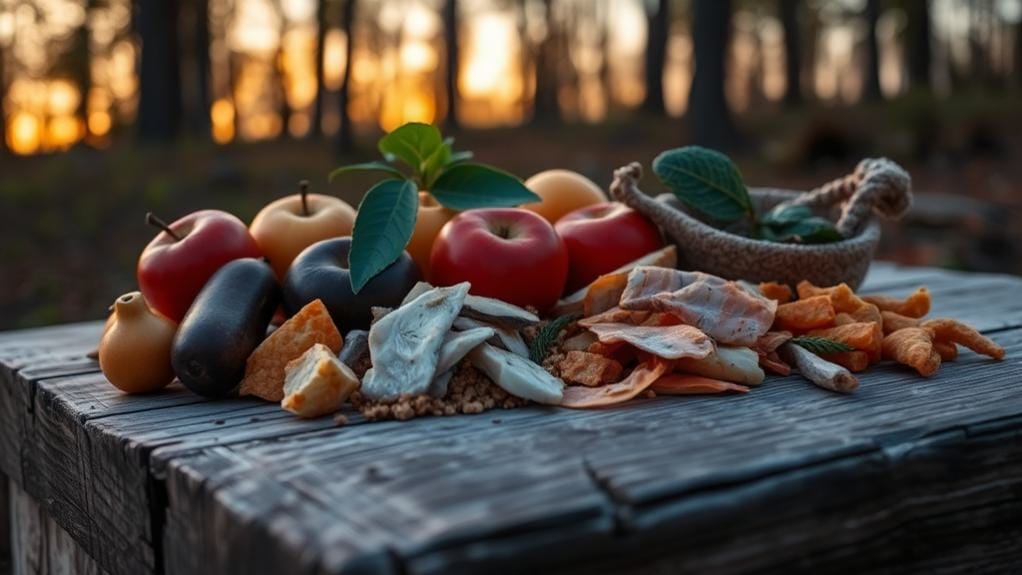
Let’s cut through the nonsense and get straight to what matters when picking opossum bait – because nobody wants to waste time with stuff that doesn’t work. I’ll show you how to weigh vital factors like safety for other animals, weather resistance, and cost against each other so you don’t burn through your budget on ineffective lures. Whether you’re dealing with a single nuisance opossum or managing a larger property, understanding how bait effectiveness changes with the seasons will make your trapping efforts way more successful.
Safety for Non-Target Animals
Safety stands at the forefront when selecting opossum bait, particularly concerning other animals in your area. Trust me, you don’t want Fluffy or Fido becoming unexpected “guests” in your trap. That’s why choosing the right bait is essential – and I’m not just saying that because I enjoy being dramatic.
Let’s get straight to what matters:
- Use specialized food-type lures made specifically for opossums. Yeah, they exist – and they’re actually less attractive to pets. Imagine that!
- Avoid baits with overpowering scents. Unless you’re planning a neighborhood pet party in your trap (spoiler alert: you’re not).
- Choose bait designed for your specific trap type. Dog-proof traps need specific bait placement. It’s not rocket science, but it matters.
*Pro Tip: Check those traps frequently. Nobody wants a hangry raccoon holding a grudge.*
Bait Durability and Weather
The durability of your opossum bait can make or break your trapping success, especially when Mother Nature decides to throw a curveball. Trust me – there’s nothing more frustrating than checking your trap only to find a soggy, ineffective mess that couldn’t attract a starving opossum if it tried.
Here’s what you need to know about weather-resistant baits:
- Look for baits containing lanolin – it’s like nature’s waterproofing system
- Choose paste formulations over loose materials (because nobody wants their bait washing away in the first drizzle)
- Invest in baits that maintain their scent even when wet (opossums aren’t going to play hide-and-seek with odorless bait)
Pro Tip: Don’t be cheap with your bait choices. Weather-resistant options might cost more upfront, but they’ll save you time and frustration in the long run.
Remember to check your baits regularly – even the toughest formulations need rejuvenation eventually. I recommend inspecting after heavy rain or extreme weather conditions. And please, don’t assume your bait is still working just because it looks okay. If it’s been through a weather war, it’s probably time for a swap.
Cost and Usage Value
Making smart financial decisions about opossum bait goes beyond just looking at the price tag. I’ve seen too many people grab the cheapest option only to waste money on multiple applications. Let’s get real about cost versus value.
Here’s what actually matters when you’re spending your hard-earned cash:
- Concentration matters: Higher-quality baits might cost more per ounce but often require less product. Do the math – it’s not rocket science.
- Package sizing is essential. Buying in bulk? You’ll typically save money per ounce. Just make sure you’ll use it all before it expires (because expired bait is about as useful as a screen door on a submarine).
Pro Tip: Look for multi-attractant formulas – they’re usually worth the extra cost.
The real value comes down to effectiveness. I don’t care how cheap your bait is if it doesn’t work. Here’s my blunt advice:
- Check user reviews religiously
- Calculate cost per successful catch, not just cost per ounce
- Consider whether you need frequent reapplication – those costs add up fast
Remember: Being cheap now often means spending more later. Sometimes you’ve got to spend money to save money.
Attractant Strength and Range
Understanding the pull and reach of your bait can make or break your opossum control efforts. Let’s be real – if your bait’s not sending out those irresistible “come and get it” signals, you might as well be throwing potato chips at the problem.
I’ll tell you what actually works:
- Combo baits are your best friend. Mix meat, fish, and sweet stuff together. Yeah, it sounds like a disgusting potluck, but opossums can’t resist it.
- Natural oils and scents are game-changers. They’re like a dinner bell that rings for miles (okay, not miles, but you get the point).
Pro Tip: Think like a weatherman for once. Wind direction matters more than you’d guess.
Here’s what you need to watch:
- Specialized opossum baits trump your leftover tuna sandwich every time
- Strong-smelling foods work best – if it makes you wrinkle your nose, you’re probably on the right track
- Environmental factors can mess with your bait’s reach, so placement is essential
Remember: A weak attractant is like a whisper at a rock concert – totally pointless. Go strong or go home.
Seasonal Bait Effectiveness
Throughout the year, choosing the right opossum bait requires careful consideration of seasonal changes. Let’s face it – these crafty critters aren’t going to fall for the same tricks year-round. You’ve got to think like an opossum (scary thought, I know).
During warmer months, here’s what you need to know:
- Fresh fruits and protein-rich baits are your best bet
- Natural food sources are abundant, so you’ll need extra-tempting options
- Night baiting works better (yeah, you might need to set that alarm)
When winter rolls around, switch it up:
- High-fat baits become irresistible
- Animal fats and oils are top choices
- They’re less active, so placement matters more than timing
*Pro Tip: Rain and snow can mess with your bait’s scent trail. When the weather’s nasty, go for stronger-smelling options. Think “essence of roadkill” (kidding… sort of).*
Placement and Application Methods
The strategic placement of opossum bait can make or break your trapping success. Let’s be real – you can’t just toss some fruit in your backyard and expect possums to come running like they’re at an all-you-can-eat buffet. You’ve got to be smart about this.
First, do your detective work:
- Look for droppings and tracks (yes, you’ll need to get up close and personal with possum poop)
- Identify their pathways – these critters are creatures of habit
- Find their burrows or favorite hangout spots
Pro Tip: If you’re not finding signs, you’re probably looking in the wrong places. They’re nocturnal, not invisible.
When placing bait:
- Use small amounts – we’re not feeding an army here
- Keep it fresh and protected from rain (soggy bait = wasted effort)
- Place it near, but not directly in, your trap entrance
- Use dog-proof or cage traps exclusively
Remember: You want to mimic their natural feeding patterns. Think like a possum – if you wouldn’t eat something that’s been sitting in the rain for three days, neither will they. Keep it fresh, keep it strategic, and most importantly, keep it legal.
Legal Compliance Requirements
Every responsible trapper needs to navigate a maze of legal requirements before setting out opossum bait. Trust me – you don’t want to learn this stuff the hard way by getting slapped with fines or worse.
Before you get all excited about your opossum-catching plans, here’s what you absolutely must do:
- Check your local wildlife regulations. Seriously. Some places treat opossums like royalty with special protections. Who knew?
- Make sure your bait choice is legal. You’d be surprised what’s not allowed in some states. That fancy animal-based lure might get you in hot water.
- Get your paperwork in order. Many areas require permits for trapping. Yeah, I know – more bureaucracy.
Pro Tip: Keep digital copies of permits on your phone. Way better than discovering they’re sitting on your kitchen counter when a wildlife officer shows up.
Don’t forget about humane trapping laws. You can’t just leave those traps out there and forget about them like last week’s leftovers. Regular checks are mandatory in most places.
The bottom line? Do your homework on local regulations or prepare for some seriously uncomfortable conversations with wildlife authorities.
Food Vs Chemical Lures
Now that you’re clear on the legal requirements, picking the right type of bait can make or break your opossum trapping success. Let me be blunt – food lures absolutely crush chemical alternatives when it comes to catching opossums. Why? Because these critters are natural-born foodies who can’t resist a good meal.
Here’s what you need to know about your bait options:
Food Lures:
- Natural ingredients that opossums actually want to eat (crazy concept, right?)
- Zero risk of accidentally poisoning neighborhood pets
- Environmentally friendly – because Mother Nature doesn’t need more chemicals
- Creates an irresistible scent trail that screams “dinner time!”
Chemical Lures:
- Sure, they might work… if you enjoy attracting every random animal except opossums
- Risk turning your yard into an accidental toxic zone
- Usually cost more than good old-fashioned food bait
Pro Tip: Fresh fruits and meats will outperform fancy chemical concoctions every time. Trust me, I’ve learned this the hard way.
Bottom line: Skip the synthetic stuff and stick with food-based lures. Your success rate (and conscience) will thank you.
Frequently Asked Questions
How Long Does Opossum Bait Remain Effective in Wet Weather Conditions?
I’ve found that most opossum bait loses effectiveness within 24-48 hours in wet weather. I recommend checking and replacing your bait daily when it’s raining to maintain its attractiveness to opossums.
Can Opossum Baits Attract Other Unwanted Wildlife to My Property?
Yes, I want to warn you that opossum baits like fruits, vegetables, and pet food can definitely attract other animals. You’ll likely see raccoons, skunks, cats, and even rats coming to investigate your bait.
What Time of Year Is Best for Using Opossum Bait?
Like clockwork, I’ll tell you that I’ve found spring and fall are your prime baiting seasons. I recommend avoiding summer’s heat when bait spoils quickly and winter when opossums are less active.
Are Homemade Opossum Baits as Effective as Commercial Products?
I’ve found homemade baits can be just as effective as commercial ones. From my experience, overripe fruits, cat food, or leftover meat work great. You’ll save money and get similar results with these DIY options.
How Far Should Bait Stations Be Placed From Residential Buildings?
I recommend placing bait stations at least 50-100 feet from your home. You’ll want them far enough to avoid attracting opossums near your living space but close enough to monitor activity.
Last Word
Let me be real with you – dealing with opossums isn’t exactly a walk in the park. I’ve found these “trash pandas’ cousins” respond best to the baits we’ve covered when you’re patient and strategic. Whether you’re humanely relocating them or protecting your property, choose your bait wisely. Just remember: these critters are actually nature’s clean-up crew, so consider deterrence before removal. Your end goal matters most in picking the right approach.

